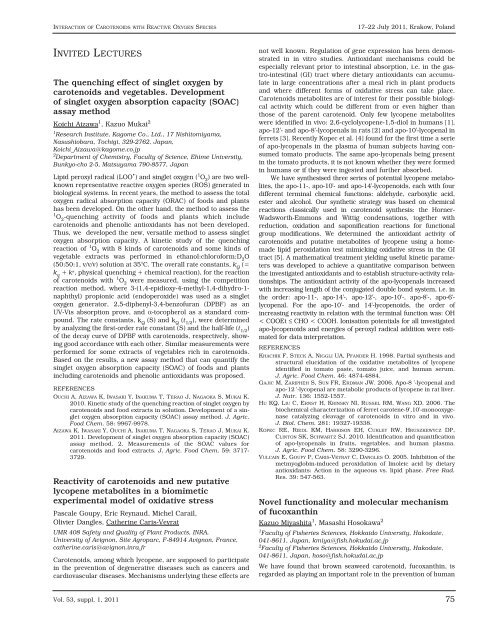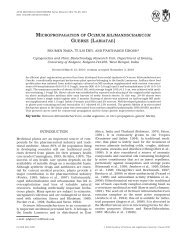ACTA BIOLOGICA CRACOVIENSIA
ACTA BIOLOGICA CRACOVIENSIA
ACTA BIOLOGICA CRACOVIENSIA
You also want an ePaper? Increase the reach of your titles
YUMPU automatically turns print PDFs into web optimized ePapers that Google loves.
INTERACTION OF CAROTENOIDS WITH REACTIVE OXYGEN SPECIES<br />
INVITED LECTURES<br />
The quenching effect of singlet oxygen by<br />
carotenoids and vegetables. Development<br />
of singlet oxygen absorption capacity (SOAC)<br />
assay method<br />
Koichi Aizawa1 , Kazuo Mukai2 1 Research Institute, Kagome Co., Ltd., 17 Nishitomiyama,<br />
Nasushiobara, Tochigi, 329-2762, Japan,<br />
Koichi_Aizawa@kagome.co.jp<br />
2 Department of Chemistry, Faculty of Science, Ehime University,<br />
Bunkyo-cho 2-5, Matsuyama 790-8577, Japan<br />
Lipid peroxyl radical (LOO • ) and singlet oxygen ( 1 O 2 ) are two wellknown<br />
representative reactive oxygen species (ROS) generated in<br />
biological systems. In recent years, the method to assess the total<br />
oxygen radical absorption capacity (ORAC) of foods and plants<br />
has been developed. On the other hand, the method to assess the<br />
1 O2 -quenching activity of foods and plants which include<br />
carotenoids and phenolic antioxidants has not been developed.<br />
Thus, we developed the new, versatile method to assess singlet<br />
oxygen absorption capacity. A kinetic study of the quenching<br />
reaction of 1 O 2 with 8 kinds of carotenoids and some kinds of<br />
vegetable extracts was performed in ethanol:chloroform:D 2 O<br />
(50:50:1, v/v/v) solution at 35°C. The overall rate constants, k Q (=<br />
k q + k r, physical quenching + chemical reaction), for the reaction<br />
of carotenoids with 1 O 2 were measured, using the competition<br />
reaction method, where 3-(1,4-epidioxy-4-methyl-1,4-dihydro-1naphthyl)<br />
propionic acid (endoperoxide) was used as a singlet<br />
oxygen generator, 2,5-diphenyl-3,4-benzofuran (DPBF) as an<br />
UV-Vis absorption prove, and α-tocopherol as a standard compound.<br />
The rate constants, k Q (S) and k Q (t 1/2 ), were determined<br />
by analyzing the first-order rate constant (S) and the half-life (t 1/2 )<br />
of the decay curve of DPBF with carotenoids, respectively, showing<br />
good accordance with each other. Similar measurements were<br />
performed for some extracts of vegetables rich in carotenoids.<br />
Based on the results, a new assay method that can quantify the<br />
singlet oxygen absorption capacity (SOAC) of foods and plants<br />
including carotenoids and phenolic antioxidants was proposed.<br />
REFERENCES<br />
OUCHI A, AIZAWA K, IWASAKI Y, INAKUMA T, TERAO J, NAGAOKA S, MUKAI K.<br />
2010. Kinetic study of the quenching reaction of singlet oxygen by<br />
carotenoids and food extracts in solution. Development of a singlet<br />
oxygen absorption capacity (SOAC) assay method. J. Agric.<br />
Food Chem. 58: 9967-9978.<br />
AIZAWA K, IWASAKI Y, OUCHI A, INAKUMA T, NAGAOKA S, TERAO J, MUKAI K.<br />
2011. Development of singlet oxygen absorption capacity (SOAC)<br />
assay method. 2. Measurements of the SOAC values for<br />
carotenoids and food extracts. J. Agric. Food Chem. 59: 3717-<br />
3729.<br />
Reactivity of carotenoids and new putative<br />
lycopene metabolites in a biomimetic<br />
experimental model of oxidative stress<br />
Pascale Goupy, Eric Reynaud, Michel Carail,<br />
Olivier Dangles, Catherine Caris-Veyrat<br />
UMR 408 Safety and Quality of Plant Products, INRA,<br />
University of Avignon, Site Agroparc, F-84914 Avignon, France,<br />
catherine.caris@avignon.inra.fr<br />
Carotenoids, among which lycopene, are supposed to participate<br />
in the prevention of degenerative diseases such as cancers and<br />
cardiovascular diseases. Mechanisms underlying these effects are<br />
Vol. 53, suppl. 1, 2011<br />
17–22 July 2011, Krakow, Poland<br />
not well known. Regulation of gene expression has been demonstrated<br />
in in vitro studies. Antioxidant mechanisms could be<br />
especially relevant prior to intestinal absorption, i.e. in the gastro-intestinal<br />
(GI) tract where dietary antioxidants can accumulate<br />
in large concentrations after a meal rich in plant products<br />
and where different forms of oxidative stress can take place.<br />
Carotenoids metabolites are of interest for their possible biological<br />
activity which could be different from or even higher than<br />
those of the parent carotenoid. Only few lycopene metabolites<br />
were identified in vivo: 2,6-cyclolycopene-1,5-diol in humans [1],<br />
apo-12'- and apo-8'-lycopenals in rats [2] and apo-10'-lycopenal in<br />
ferrets [3]. Recently Kopec et al. [4] found for the first time a serie<br />
of apo-lycopenals in the plasma of human subjects having consumed<br />
tomato products. The same apo-lycopenals being present<br />
in the tomato products, it is not known whether they were formed<br />
in humans or if they were ingested and further absorbed.<br />
We have synthesised three series of potential lycopene metabolites,<br />
the apo-11-, apo-10'- and apo-14'-lycopenoids, each with four<br />
different terminal chemical functions: aldehyde, carboxylic acid,<br />
ester and alcohol. Our synthetic strategy was based on chemical<br />
reactions classically used in carotenoid synthesis: the Horner-<br />
Wadsworth-Emmons and Wittig condensations, together with<br />
reduction, oxidation and saponification reactions for functional<br />
group modifications. We determined the antioxidant activity of<br />
carotenoids and putative metabolites of lycopene using a homemade<br />
lipid peroxidation test mimicking oxidative stress in the GI<br />
tract [5]. A mathematical treatment yielding useful kinetic parameters<br />
was developed to achieve a quantitative comparison between<br />
the investigated antioxidants and to establish structure-activity relationships.<br />
The antioxidant activity of the apo-lycopenals increased<br />
with increasing length of the conjugated double bond system, i.e. in<br />
the order: apo-11-, apo-14'-, apo-12'-, apo-10'-, apo-8'-, apo-6'lycopenal.<br />
For the apo-10'- and 14'-lycopenoids, the order of<br />
increasing reactivity in relation with the terminal function was: OH<br />
< COOEt ≤ CHO < COOH. Ionisation potentials for all investigated<br />
apo-lycopenoids and energies of peroxyl radical addition were estimated<br />
for data interpretation.<br />
REFERENCES<br />
KHACHIK F, STECK A, NIGGLI UA, PFANDER H. 1998. Partial synthesis and<br />
structural elucidation of the oxidative metabolites of lycopene<br />
identified in tomato paste, tomato juice, and human serum.<br />
J. Agric. Food Chem. 46: 4874-4884.<br />
GAJIC M, ZARIPHEH S, SUN FR, ERDMAN JW. 2006. Apo-8 '-lycopenal and<br />
apo-12 '-lycopenal are metabolic products of lycopene in rat liver.<br />
J. Nutr. 136: 1552-1557.<br />
HU KQ, LIU C, ERNST H, KRINSKY NI, RUSSEL RM, WANG XD. 2006. The<br />
biochemical characterization of ferret carotene-9',10'-monooxygenase<br />
catalyzing cleavage of carotenoids in vitro and in vivo.<br />
J. Biol. Chem. 281: 19327-19338.<br />
KOPEC RE, RIEDL KM, HARRISON EH, CURLEY RW, HRUSZKEWYCZ DP,<br />
CLINTON SK, SCHWARTZ SJ. 2010. Identification and quantification<br />
of apo-lycopenals in fruits, vegetables, and human plasma.<br />
J. Agric. Food Chem. 58: 3290-3296.<br />
VULCAIN E, GOUPY P, CARIS-VEYRAT C, DANGLES O. 2005. Inhibition of the<br />
metmyoglobin-induced peroxidation of linoleic acid by dietary<br />
antioxidants: Action in the aqueous vs. lipid phase. Free Rad.<br />
Res. 39: 547-563.<br />
Novel functionality and molecular mechanism<br />
of fucoxanthin<br />
Kazuo Miyashita 1 , Masashi Hosokawa 2<br />
1<br />
Faculty of Fisheries Sciences, Hokkaido University, Hakodate,<br />
041-8611, Japan, kmiya@fish.hokudai.ac.jp<br />
2Faculty of Fisheries Sciences, Hokkaido University, Hakodate,<br />
041-8611, Japan, hoso@fish.hokudai.ac.jp<br />
We have found that brown seaweed carotenoid, fucoxanthin, is<br />
regarded as playing an important role in the prevention of human<br />
75












